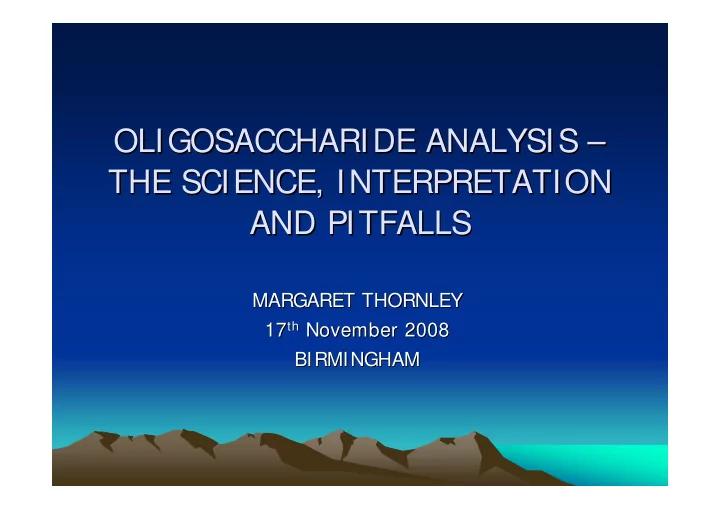

OLIGOSACCHARIDE ANALYSIS – – OLIGOSACCHARIDE ANALYSIS THE SCIENCE, INTERPRETATION THE SCIENCE, INTERPRETATION AND PITFALLS AND PITFALLS MARGARET THORNLEY MARGARET THORNLEY th November 2008 17 th November 2008 17 BIRMINGHAM BIRMINGHAM
WHY SCREEN FOR WHY SCREEN FOR OLIGOSACCHARIDES? OLIGOSACCHARIDES? A number of inherited genetic disorders show abnormal amounts of oligosaccharides in urine Testing urine is a non-invasive procedure especially useful with young babies Screening urine for oligosaccharides can initially identify some oligosaccharidurias Some symptoms of oligosaccharidurias may also apply to other diseases and it is important to differentiate these
COMMON OLIGOSACCHARIDOSES COMMON OLIGOSACCHARIDOSES GM1 Gangliosidosis a -mannosidosis b -mannosidosis a -fucosidosis Neuraminidase deficiency (sialidosis) Sialicaciduria (ISSD, Salla disease) Galactosialidosis Aspartylglucosaminuria
THE SCIENCE THE SCIENCE Medical / clinical • Clinical symptoms • Clinical diagnosis Biochemical • Screening • Biochemical diagnosis
SCIENCE – – CLINICAL SYMPTOMS CLINICAL SYMPTOMS SCIENCE Face Dyst Neur Organo Eyes Histology Others Multi megaly a -mann Coarse +++ MR +++ Cats Vacuoles Hearing Cloud loss b -mann Dysm- +/- MR - Normal Normal Angio- orphic keratoma Fucosidosis Coarse ++ MR ++ + Vacuoles Angio- keratoma Sialidosis Coarse +++ MR +/- Cherry Vacuoles Hydrops red Angio- spot keratoma GM1 gang Dysm- + MR ++ Cherry Vacuoles Skeletal orphic red spot
SCIENCE - -DEGRADATION OF COMPLEX DEGRADATION OF COMPLEX SCIENCE OLIGOSACCHARIDES OLIGOSACCHARIDES
SCIENCE - - BIOCHEMICAL BIOCHEMICAL SCIENCE Screening • Thin layer chromatography • HPLC • MS / MS Diagnosis • Enzyme Analysis (except for ISSD) • Mutation Analysis
SCREENING – – THIN LAYER THIN LAYER SCREENING CHROMATOGRAPHY CHROMATOGRAPHY TLC – separation of compounds utilising their different solubility properties Thin layer of silica gel 60 on a plastic support Stand in solvent to give ascending chromatography Visualise by spraying with chemicals and heating to enable a colour reaction
SCREENING – – THIN LAYER THIN LAYER SCREENING CHROMATOGRAPHY CHROMATOGRAPHY TLC for oligosaccharides • Solvent 1: Butanol / acetic acid / water 2:1:1 run twice TLC for sialic acid (N-acetyl neuraminic acid) • Solvent 1: Butanol / acetic acid / water 2:1:1 run once followed by • Solvent 2: Propan-1-ol / nitromethane / water 5:4:3 run twice
TLC continued TLC continued Staining thin layers • Oligosaccharides – orcinol stain • Sialic acid – resorcinol stain (after spraying with stain place thin layer plate between glass to maintain the acid atmosphere during heating)
Interpretation Interpretation Bands running between the origin and level with the band from lactose ( a disaccharide) are the oligosaccharides becoming sequentially larger as they near the origin
Interpretation Interpretation Some identifiable patterns a -mannosidosis – strong trisaccharide band with other bands stepwise downwards b -mannosidosis – strong disaccharide band with other bands stepwise downwards GM1 gangliosidosis – strong band close to origin plus other band above Sialidosis (neuraminidase deficiency) – many bands of bound sialic acid Sialic storage (ISSD) – heavy band of free sialic acid Galactosialidosis – mixture of sialidosis and GM1
TLC patterns TLC patterns a -mann a -mann b -mann Standards post-BMT
TLC patterns TLC patterns a -Fuc a -Fuc AGA
TLC patterns TLC patterns ISSD Neur
TLC patterns TLC patterns a -man GM1 GalSial
Pitfalls Pitfalls Patterns from young babies are often deceptive Jaundiced babies show heavy patterns Other causes, eg liver damage, produce oiligosaccharides Not all patients suffering from an oligosaccharidosis show oligosaccharides in the urine – a -fucosidosis very difficult to spot Needs experience to interpret patterns Age makes a difference Disease severity makes a difference
SOMETHING TO REMEMBER SOMETHING TO REMEMBER THIS IS ONLY A SCREENING METHOD, NOT A DIAGNOSTIC METHOD IF CLINICAL SYMPTOMS CLEARLY INDICATE A POSSIBLE OLIGOSACCHARIDOSIS, FOLLOW UP WITH ENZYME ANALYSIS EVEN IF THE SCREEN APPEARS NEGATIVE
Recommend
More recommend